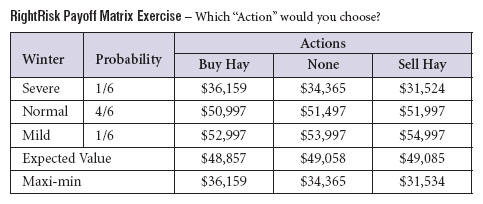The last tactical step is determining a risk
management plan. Your choice will depend on your tolerance for risk
(Steps 1 and 2); your goals (Step 3); and your risk management
alternatives (Steps 4, 5, and 6).
Consider the example in the inset box. If you had to decide how much
hay to store for your cattle, keeping in mind winter weather
uncertainties, would you buy more hay, keep the amount that you
produced, or sell some
 of your hay? If you knew the winter would be severe, you would buy hay.
If you knew the winter was going to be mild, you would sell hay.
However, uncertain weather conditions mean that the weather may be mild,
normal, or severe, yielding nine possible financial outcomes. In this
example, if you were not concerned about risk, you would maximize the
expected return by selling hay ($49,085). If you were extremely risk
averse, you might try to minimize a bad outcome (Maxi-min). Under the
Maxi-min strategy, you would choose to buy hay, where the worst return
you could get would be $36,159. The SRMP offers many tools to help you
adjust for uncertainty and to help you develop farm management plan that
is tailored just for your level of risk preference.
of your hay? If you knew the winter would be severe, you would buy hay.
If you knew the winter was going to be mild, you would sell hay.
However, uncertain weather conditions mean that the weather may be mild,
normal, or severe, yielding nine possible financial outcomes. In this
example, if you were not concerned about risk, you would maximize the
expected return by selling hay ($49,085). If you were extremely risk
averse, you might try to minimize a bad outcome (Maxi-min). Under the
Maxi-min strategy, you would choose to buy hay, where the worst return
you could get would be $36,159. The SRMP offers many tools to help you
adjust for uncertainty and to help you develop farm management plan that
is tailored just for your level of risk preference.

